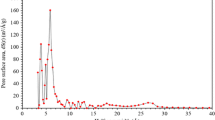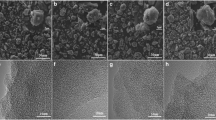Abstract
The effects of pore length distribution (PLD) and solution resistance, R sol, on the kinetics of double-layer charging/discharging of the activated carbon fiber cloth electrode (ACFCE) were investigated in a 30 wt% H2SO4 solution using nitrogen gas adsorption, a.c. impedance spectroscopy, the current transient technique, and cyclic voltammetry. The impedance spectra of the ACFCE were theoretically calculated based upon the transmission line model in consideration of the pore size distribution (PSD) and the PLD. From comparison of both the experimental and theoretical impedance spectra of the ACFCE, it is suggested that the deviation from the ideal impedance behavior of a cylindrical pore in the experimental impedance spectrum of the ACFCE is mainly ascribed to PLD, rather than to PSD. The cathodic current transients and cyclic voltammograms were theoretically calculated based upon the transmission line model as functions of the standard deviation σ of the PLD and R sol. From the results, it is concluded that ion penetration into the pores is closely related to both σ and R sol during double-layer charging/discharging of the ACFCE, that is, the larger σ and R sol, the lower is the rate capability, thus causing higher retardation of ion penetration into the pores.







Similar content being viewed by others
References
Ishikawa M, Sakamoto A, Morita M, Matsuda Y, Isida K (1996) J Power Sources 60:233
Momma T, Liu X, Osaka T, Ushio Y, Sawada Y (1996) J Power Sources 60:249
Qu D, Shi H (1998) J Power Sources 74:99
Nakagawa H, Shudo A, Miura K (2000) J Electrochem Soc 147:38
Weng TC, Teng H (2001) J Electrochem Soc 148:A368
Kim CH, Pyun SI, Shin HC (2002) J Electrochem Soc 149:A93
Pyun SI, Kim CH, Kim SW, Kim JH (2002) J New Mater Electrochem Syst 5:289
Song HK, Lee YH, Dao Le H (1999) Electrochim Acta 44:3513
Jin X, Zhuang L, Lu J (2001) J Electroanal Chem 519:137
Brunauer S, Emmett PH, Teller E (1938) J Am Chem Soc 60:309
Horvath G, Kawazoe K (1983) J Chem Eng Jpn 16:470
Soffer A, Folman M (1972) J Electroanal Chem 38:25
Shi H (1996) Electrochim Acta 41:1633
Oshida K, Kogiso K, Takeuchi K, Kobayashi S, Endo M, Dresselhaus MS, Dresselhaus G (1995) J Mater Res 5:2507
Daley MA, Tandon D, Economy J, Hippo EJ (1996) Carbon 34:1191
de Levie R (1964) Electrochim Acta 9:1231
de Levie R (1965) Electrochim Acta 10:113
de Levie R (1967) Advances in electrochemistry and electrochemical engineering, vol VI. John Wiley & Sons, New York, p 329
Candy JP, Fouilloux P (1980) Electrochim Acta 26:1029
Posey FA, Morozumi T (1966) J Electrochem Soc 113:176
Austin LG, Gagnon EG (1973) J Electrochem Soc 120:251
Diard JP, Le Gorrec B, Montella C (2001) J Electroanal Chem 499:67
Acknowledgements
This work was supported by a grant no. R01-2000-000-00240-0 from Korea Science & Engineering Foundation. This work was partly supported by the Brain Korea 21 project.
Author information
Authors and Affiliations
Corresponding author
Rights and permissions
About this article
Cite this article
Lee, GJ., Pyun, SI. & Kim, CH. Kinetics of double-layer charging/discharging of the activated carbon fiber cloth electrode: effects of pore length distribution and solution resistance. J Solid State Electrochem 8, 110–117 (2004). https://doi.org/10.1007/s10008-003-0392-x
Received:
Accepted:
Published:
Issue Date:
DOI: https://doi.org/10.1007/s10008-003-0392-x




